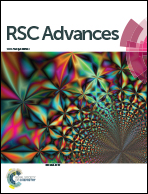The direct growth of planar and vertical graphene on Si(100) via microwave plasma chemical vapor deposition: synthesis conditions effects†
Abstract
In the present research, graphene was synthesized directly on a Si(100) substrate via combining direct microwave plasma-enhanced chemical vapor deposition and protective enclosure. The graphene flake orientation was controlled using suitable synthesis conditions. We revealed that high processing temperatures and plasma powers promote vertical graphene growth. The main related physical mechanisms were raised temperature gradients, thermal stress, ion bombardment, and elevated electric field effects. Lowering the synthesis temperature and plasma power resulted in planar graphene growth. An elevated synthesis temperature and long deposition time decreased the graphene layer number as the carbon desorption rate increased with temperature. Dominating defect types and their relationships to the graphene growth conditions were revealed. Planar graphene n-type self-doping was found due to substrate-based charge transfer. In the case of vertical graphene, the increased contact area between graphene and air resulted in the adsorption of more molecules, resulting in no doping or p-type doping.



 Please wait while we load your content...
Please wait while we load your content...